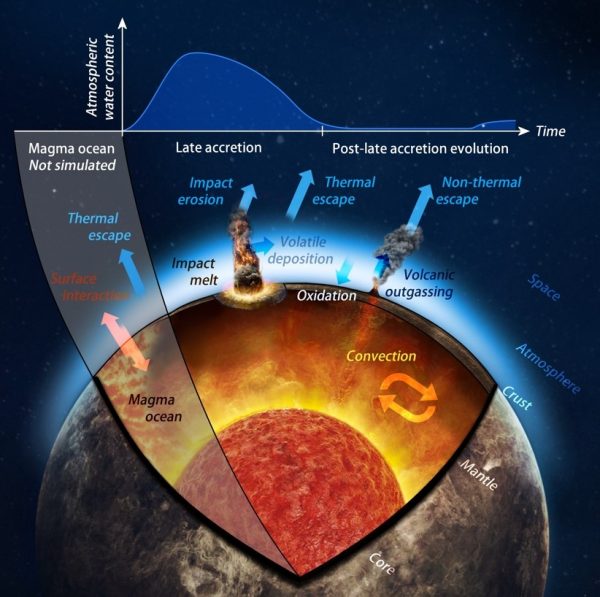Why Earth is the Blue Planet
An international team of scientists, with participation of NCCR PlanetS and ETH Zurich, investigated the origin of water on Earth. Their results suggest that it has been here all along.
Is the abundance of water on Earth special? The exploration of other rocky planets and their discovered lack of surface water indicates that it is indeed.
This leaves the question of its origin. There are only two possibilities:
- Water was brought to Earth by icy or water-rich asteroids, after the giant impact that formed the Moon, and Earth had grown to 99% of its current size
- Water was already inherent in the building blocks of Earth.
Because of the importance of water to sustain life, the question of the origin of water on Earth is important. A major challenge in investigating this question is that Earth has lost all the traces of its formation since it is an active planet.
A team of numerical modelers and geochemists led by Cédric Gillmann of the Université Libre de Bruxelles (previously at ETH Zurich) decided to look far beyond Earth – up to Venus – to investigate the origin of terrestrial water.
While Earth and Venus could be considered as twin sisters, their respective geological and climatic evolutions diverged dramatically in the past. This lead to Venus’ present-day 92 bar atmosphere heated by an infernal greenhouse up to 740 K (466 ° C). A stark contrast to the mild conditions and only 1 bar pressure at the surface of Earth.

However, Venus’ volcanic activity and outgassing are reduced compared to Earth, because it has no plate tectonics. Instead, its stagnant lid and the associated convection mode imply very little recycling of volatile material into the mantle. As such, despite being an inferno, the evolution of the atmosphere of Venus is much easier to understand and model over geological times. In addition, because of their proximity, the Earth and Venus should have received the same type of material during their history. All these aspects combine to make Venus a perfect place to study the primitive evolution of terrestrial planets.
Gillmann et al. numerically simulated impacts of different types of asteroids containing various amounts of water. The team discovered that water-rich asteroids colliding with Venus and releasing their water as vapor cannot explain the composition of Venus atmosphere as we measure it today.
This implies that the asteroidal material that came to Venus, and thus to Earth, late in the formation history, must have been dry. Therefore it did not replenish Earth’s water, indicating that the water we are now enjoying on Earth has been there since its formation. It was likely buried deep in the Earth so it could survive the giant impact, as e.g. implicated in previous work of team member Maria Schönbächler of PlanetS and ETH Zurich.
This result has implications in terms of the habitability of ancient Earth, Venus and Mars. It suggests that planets likely formed with their near-full budget in water, and slowly lost it with time. For Venus, the results complement recent work advocating that water oceans existed at the surface of the planet, and help to constrain the maximum amount of water that can be expected on Venus. This will also help prepare the next generation of space missions to Venus.
This article was first published by Arian Bastani on the external page PlanetS website.
Reference
C. Gillmann, G. J. Golabek, S. N. Raymond, M. Schönbächler, P. J. Tackley, V. Dehant & V. Debaille. Dry late accretion inferred from Venus’s coupled atmosphere and internal evolution. Nature Geoscience 13, 265–269 (2020). doi: external page https://doi.org/10.1038/s41561-020-0561-x